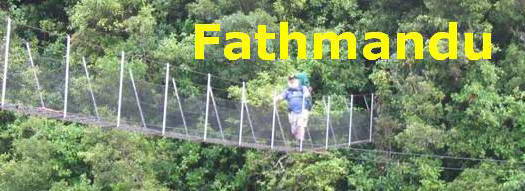
Many thanks for permission to use graphics from their software and toposheets |
 |
|
29 August 2007 Huia Dam Rd —from Dam to Dampage 2 Off to the right a goose floats peacefully. Probably paddling like hell where it matters....
The goldy-bronze of a young Coprosma arborea catches my attention. I've often said that New Zealand bush has an overall green colour that is unique, but inside that complex, as you get to know it, often the first sighting of a particular species is its own particular colour standing out from the background.
Mind you, it's not just New Zealand plants that do this.
I presume this also is a weed, though not an unattractive one. I don't have a name for it, but if anybody else does....
(Oh dear. It's called a mist flower - Ageratina riparia - and it's one of our pest plants. The Rodney District Council publication, Plant Me Instead, notes "Completely smothers desirable plant communities, causes sediment build up, flooding and instability in steep gullies and streams." The good news is that two recently released biological control agents, one fungal and the other a gallfly, appear to be doing their job extremely well. DCW) While it is common right along the track, I find only one mingimingi (Leucopogon fasciculatum) in flower.
It's rather beautiful so I spend a little time with it.
These will turn into translucent red berries, distinguishing it from the opaque red, white and pink berries of the other mingimingi, Cyathodes juniperina. A somewhat bedraggled akeake (Dodonia viscosa) sits back a little from the road. It's by no means uncommon - in fact, along with whau and koromiko and pink manuka, it's one of the darlings of the local council landscaping departments - but by the same token, you can walk many tracks in the Waitakeres and never see one. Part of the interest in a track or in an area can be in what is not growing there as well as in what is.
Not far away, a slightly scruffy and raffish karamu is already carrying a few flower buds.
Another Coprosma arborea provides a fine display of weathered bronze.
We're still beside the lake, but, as we get further along, the trees on either side get taller and move in on us.
The lake is still right there, though it's more just glimpses we get of the light coming off the water through the screen of tall scrub.
The odd lacebark contributes it's particular shade of bluey green. Not an obvious blue but a cast that separates it from other species, that becomes more obvious when the sun is not shining on it.
I'm still not completely sure when it comes to the various sedges and grasses along the way.
This one is more droopy and leaves come off along a main stalk.
This one, further along, is more erect and it's leaves are longer
Here's a young mahoe (Melicytus ramiflorus) . This one is again quite common, but I notice I don't usually see it alongside karapapa (Alseuosmia banksii), it's mostly either/or in that particular forest niche. And certainly I don't see karapapa today. But lots of mahoe.
Another bridge, and this is the end of the flat bit. A large mahoe hangs over one side of the stream and kanuka borders the edge of the lake.
|
|